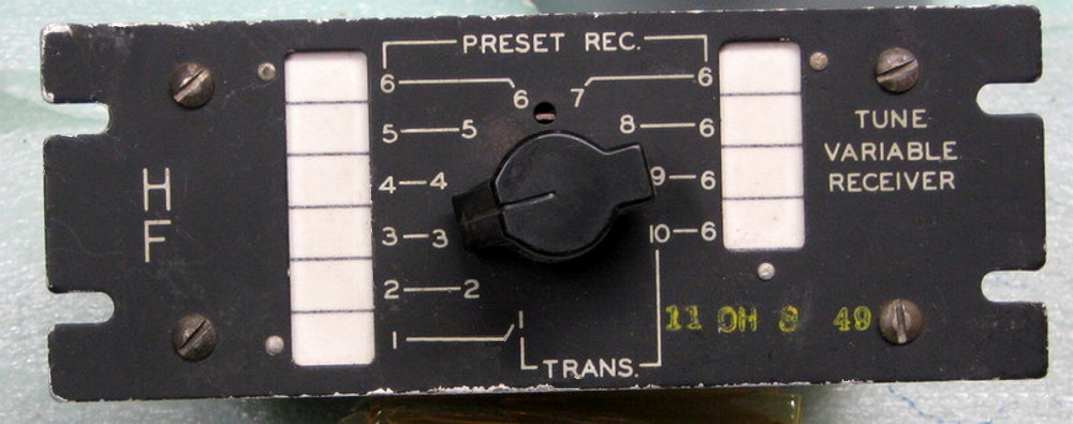The explosion of avionics on WWII aircraft quickly made control boxes almost unmanageable from a human factors standpoint. It was roughly the equivalent of the 1930's household that had one ceiling light fixture, from which emanated multiple extension cords hanging all over the walls and floor. Add to it the lack of consistency on where the boxes were mounted from aircraft to aircraft, and you had a real mess on your hands. Sometime in 1944, someone had the bright idea of emulating the 19" rack mounting system long used in industry to solve the same problem. The new width standard was 6" to accommodate the smaller control constellation required for each avionics device, but the idea was the same - stack them up and hide all the connecting cables from view and possible contact. The particular control heads shown below were most closely associated with the ARC-5, though they were later used for other sets - a tribute to the effectiveness of the modular concept. I have one of the panels here in which is mounted a 1936 Ford ash tray, used in Boeing aircraft through about 1950, and another that has a Hamilton 37500 five dial aircraft clock, so they were used for more than control heads. About the time of the Korean War, the 6" panels began to be gradually changed out in favor of the 5 3/4" standard still used today, these later panels having backlit plexiglass overlays to softly illuminate the control markings and Dzus quarter turn fasteners substituted for the old panel screws to aid in removal and replacement. Many of the older 6" units were converted to this later format by chopping 1/8" off each side and installing the Dzus fasteners. As a result, the early unmodified rack panels have become quite scarce.
The three control heads above (from top to bottom) are the C-125/ARC for an ARC-5 receiver, a C-126/ARC (functionally identical to the C-38A/ARC-5, less the ARR-2 control portion) and a C-127/AR master power/volume control that was not restricted to ARC-5 use. The C-127 has been modified to the later 5.75" width as mentioned above, and will be returned to its original 6" configuration before mounting. There was also a C-137/ARC that was a minor variation of the C-126/ARC, so is not shown here. Schematics and other information on these "console type" boxes is contained here.
The racks to house these new control heads were not particularly standardized in overall size during the first few years, unlike the typical racks in a modern aircraft that have dozens of the panels in orderly columns. They were basically open-back consoles, but at least their use focused the operator's attention to one geographic area. Below are a couple of photos showing a typical style in one that I fabricated for a friend to hold an AN/ARC-2 control head and whatever else he wanted to include. Since I had the room, I made a small power control panel with a voltmenter in it and a jack/audio level control panel - just for fun.
Another of these console boxes used with the AN/ARC-5 is the C-189/ART-13 control head for the C-131/AR autotune mechanism installed on the R-26 and R-27/ARC-5 receivers when paired with an ATC or AN/ART-13 transmitter. That combination was used primarily in the Pacific for aircraft that needed multichannel capability without the requirement for a radio operator to retune the receiver from channel to channel. The original intent with the two autotuned ARC-5 receivers was to replace the 1942 designed RCA ARB with a 12 channel capability that spanned 3-9.1MHz, but judging by the control box designs, the deployment never grew beyond a single receiver 6 channel application. The C-189 below is the fourth variation I have seen, starting with the simple six position double pole switch specified in the preliminary manual, but that first version required jury-rigging some sort of mounting for the switch in the aircraft since it had no container. The other two were nomenclatured C-188/ART-13 and C-254/AR (also shown below), and used C-87/ART-13 style surface mount boxes. Never produced in large quantities, the C-189 seems to have been the least common, perhaps because the Collins ten channel AN/ARR-15 receiver began being deployed by the end of the war, and that receiver had much greater capabilities as a liaison set than the stopgap C-131/ARC-5 concoction. At the same time, anything fielded in the Navy usually hung on in isolated units for years, especially those that did not enjoy a front line aircraft carrier status...note the 1949 overhaul date on the C-189 and a 1953! date on the C-188.
 C-189 autotune control
C-189 autotune control
 C-188 autotune control
C-188 autotune control
 C-254/AR autotune control
C-254/AR autotune control